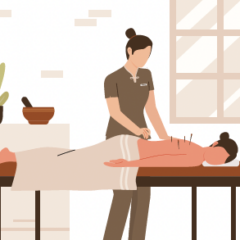Published on
American Heart Month: How to Keep Active During the Colder Months
For those living in the Northern latitudes, the winter months can bring freezing temperatures, snow, and shorter days. Even if you live in warmer climates you may still experience rain, unpredictable weather, and cooler days. After the excitement of the holidays, cozying up in blankets all winter feels really inviting. But it’s important to stay physically active even during the slowest, quietest months of the year.
Always talk to your doctor before starting any new form of exercise.
February is American Heart Month—and getting enough exercise is an important part of heart health.
According to the American Heart Association, most adults should aim to get…
- 150 minutes/week of moderate-intensity aerobic activity OR
- 75 minutes/week of vigorous aerobic activity OR
- a combination of both throughout the week
They also recommend adding in moderate- to high-intensity muscle-strengthening activity at least 2 days per week.
Moderate-intensity exercise can include things like brisk walking (at least 2.5 miles/hour), water aerobics, and gardening, and vigorous-intensity exercise can include running, tennis, and jumping rope.
These recommendations can seem like a lot if you haven’t been exercising routinely. Luckily there are lots of ways to get in those minutes here and there during the week—and the best part is that you don’t even need to leave the house.
Here are a few tips about how you can reach those exercise goals from home this winter:
Clear a space in your home for exercise
It may be hard to get started with an exercise routine if it’s been a while since you engaged in regular weekly activity. The first step can be as easy as finding a quiet space in your home. This may be a room or even a small corner where you exercise.
People taking medicines to prevent blood clots are at higher risk of bleeds, which can be caused by injury. Keeping your exercise space clear from clutter can help you keep safe.
Choose exercise activities that seem enjoyable
There are so many different types of activities that you can do from home. You can choose the type of activity you think would be most fun to do and adjust that activity to your ability level.
Just dance
Dance can be a really fun way to get moving and get your heartbeat up.
There are many different types of exercise classes available online that you can do from home. These can include Zumba, salsa, or step aerobics.
- Equipment needed: none; all you need is your feet
- Activity level: moderate (ballroom or social); vigorous (aerobic dancing)
- Adjustments: start slow when trying out dance for the first time. Look for beginner activities and take a break if you become out of breath.
Say Namaste

Yoga is a very popular form of exercise that can also easily be done from home. There are many different types you can try. Hatha focuses on your breathing, Vinyasa is faster moving, Bikram follows a set form of poses—and there are many more. Yoga classes are also available online.
- Equipment: yoga mat; support block and straps (optional)
- Activity level: light-to-moderate (depending on type of yoga and poses performed)
- Adjustments: Yoga may look soothing but it can be very challenging if your muscles are tight.
Hop on a bike

Cycling on a stationary bike is a very popular form of exercise. It may seem intimidating at first but bikes and programs are adjustable.
Jump on your bike and put on a TV show or podcast in the background—the time will fly by.
If you need something more space saving, try a desk cycle that you can use while sitting.
- Equipment: full stationary bike or desk cycle
- Activity level: moderate-to-vigorous (depending on cycling intensity and type of cycle)
- Adjustments: Start with a low speed with low elevation and stop if you’re feeling very tired. You can also increase the intensity as you go.
Try to get in some exercise every day
Some days it’s hard to even think about getting off the couch. Every day is different, and sometimes our energy levels are low—that’s OK. You should rest when you need to. But even on these days, it’s important to try to get in a little bit of activity, even if it’s only for 5 or 10 minutes.
Exercise “snacks”
For people who sit for long periods of time during the day for work, it may seem impossible to step away from your desk to get in a full exercise program. But you can actually spread a workout across the day with exercise “snacks.”
Every time you get up to get a snack, have a coffee, or go to the bathroom, extend your break to include a little bit of exercise. You can run in place, do jumping jacks, or jump rope. All of these snacks add up over the day.

We hope these tips make winter exercise at home more accessible and enjoyable. Your heart health is important all year round—and eating right and getting enough activity is something we all should strive for every day.
*Originally published in The Beat — February 2024. Read the full newsletter here.



